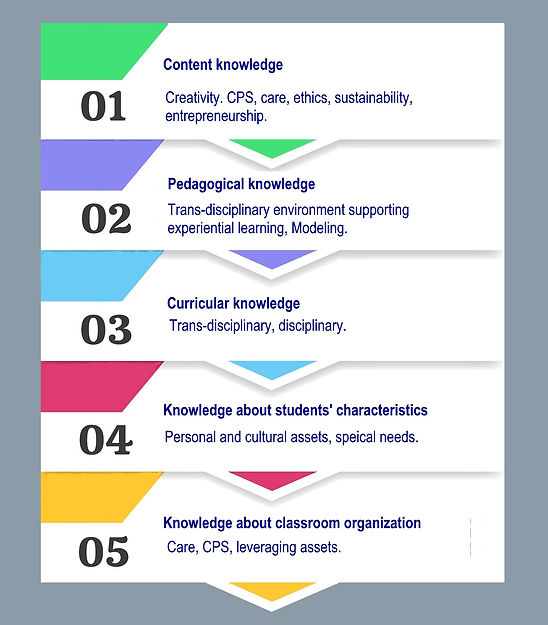Creativity and critical thinking PD - Professional Development
Welcome, listen to this podcast while reading on!
This podcast was made by Notebook LM based on Michelle Korenfeld's research paper on creativity education teacher training. enjoy!
Critical and creative thinking
It has long been foreseen that In the future workers will need to examine problems and raise personal insights (Davies, Fidler & Gorbis, 2011). Therefore, it is important to weave education for critical thinking to evaluate problems, with creative thinking to generate solutions (Paul & Elder, 2008). Critical thinking has been valued in education for long, yet creative thinking has been neglected. We see in the media expressions of criticism flooded by despair. The reason could be that critical thinking is much promoted, without its creative thinking counterpart. Teachers should foster students' ability to define problems yet also to ideate, solve, and create futures. Indeed the Creative Problem Solving process includes both clarifying challenges and implementing solutions. This website offers a holistic program for fostering both, according to a consolidated strategy, that reflects decades of teaching in the Dr. Erica Landau Institute for the Advancement of Youth to Excellence and Creativity, and The Science Oriented Youth Program in the Weizmann Institute - A pioneer program in science education and a leader of that field worldwide.
Knowledge types for critical and creative thinking PD
Shulman (1986) outlined knowledge types whose integration is significant for teacher training. The model was expanded seeking to understand how to train teachers toward collaborative, open-ended, content intensive, complex, ambiguous and unpredictable environments. Shulman & Shulman (2004) constructed a teacher training model relating to learning communities. In the new model Understanding consisted of the knowledge types outlined in the 1986 essay. Vision, Motivation, Practice, Reflection and Collegiality were added. Research regards the first model as nurturing individualistic knowledge. Yet supports the second model, in which learning is socio-constructivist. However, the first model is still widespread in teacher training (Herold, 2019).
The principal knowledge types (Shulman, 1986) and elaborations (Shulman & Shulman, 2004):
-
Content knowledge – Teachers explain why it is important to learn a subject in relation to other subjects, in theory and in practice.
-
Pedagogic knowledge - The ways to bring pupils to understand a subject. Identifying pupils' mis-conceptions that might impede learning, whichever age and background. Recommending strategies to rearrange understanding (Shulman, 1986).
-
Curricular knowledge – Understanding the alternatives to teaching based on curricula regarding texts, software, programs, visual tools, demonstrations, and enquiry channels (Shulman, 1986).
-
Knowledge about the diverse pupils' characteristics (Shulman, 1986). Understanding the learners intellectually, socially, culturally, developmentally, and personally (Shulman & Shulman, 2004).
-
Knowledge for classroom management – Generic methods for classroom organization and management (Shulman, 1986). Proactivity and responsiveness while understanding the multi-dimensional principles of collaborative learning (Shulman & Shulman, 2004).
The Ps model for creativity training
Beginning in the 60s, four creativity categories were researched: Person, Process, Product, Press of the environment. Based on which courses were developed. At first, Person was stressed - fostering individuals' creative qualities, and then Process – learning the stages toward creative solutions. At the end of the 70s and during the 80s Press of the environment was highlighted. Only in the 90s, organizations and education institutes signified Product – teaching the stages toward creative products (Murdock, & Keller-Mathers, 2011).
In the 21st century the model was expanded, and it was stressed that Potential might not be fulfilled into Performance, due to the linguistic and logical-mathematical focus, while neglecting potential in other fields (Runco, 2007). Participation relates to pupils' reflection throughout the teaching-learning processes, becoming aware of their personal profiles as contributors to idea development (Clapp, 2017). Therefore, it is important that creativity education teacher training leverages the multiple intelligences while promoting students' active participation.
The Knowledge Types for teacher creative and critical thinking PD model

Further reading:
Clapp, E. P. (2017). Participatory creativity: Introducing access and equity to the creative classroom. Routledge.
Davies, A., Fidler, D., Gorbis, M. (2011). Future Work Skills 2020. Institute for the future for the University of Phoenix Research Institute. www.iftf.org, pp. 8-13.
Herold, F. (2019). Shulman, or Shulman and Shulman? How communities and contexts affect the development of pre-service teachers’ subject knowledge. Teacher development, 23(4), 488-505.
Murdock, M., & Keller-Mathers, S. (2011). Programs and courses in creativity. In: Runco, M. A., & Pritzker, S. R. (Eds.). (2020). Encyclopedia of creativity. Academic press.
Paul, R., Elder, L. (2008). The Thinkers Guide to the Nature and Functions of Critical and Creative Thinking. Kindle edition, part 1.
Runco, M. A. (2007). A hierarchical framework for the study of creativity. New Horizons in Education, 55(3), 1-9.
Shulman, L. S. (1986). Those who understand: Knowledge growth in teaching. Journal of Education, 193(3), 1-11.
Shulman, L. S., & Shulman, J. H. (2004). How and what teachers learn: A shifting perspective. Journal of curriculum studies, 36(2), 257-271.